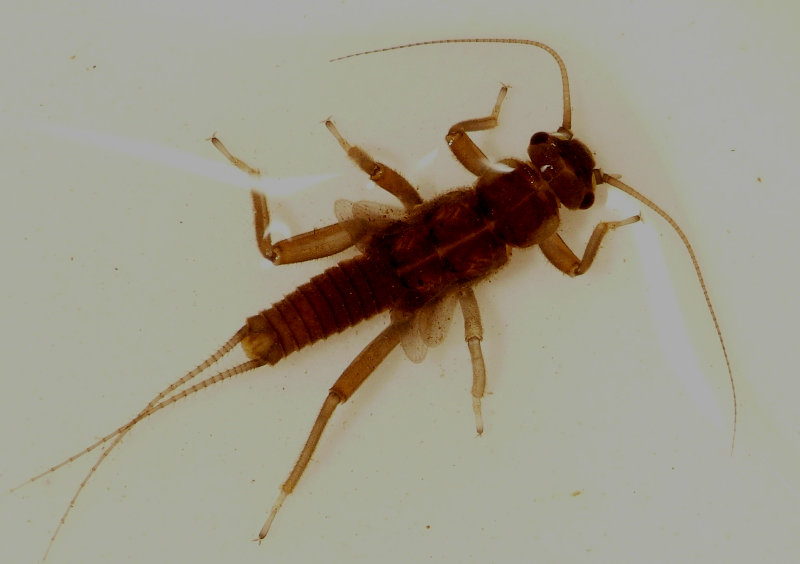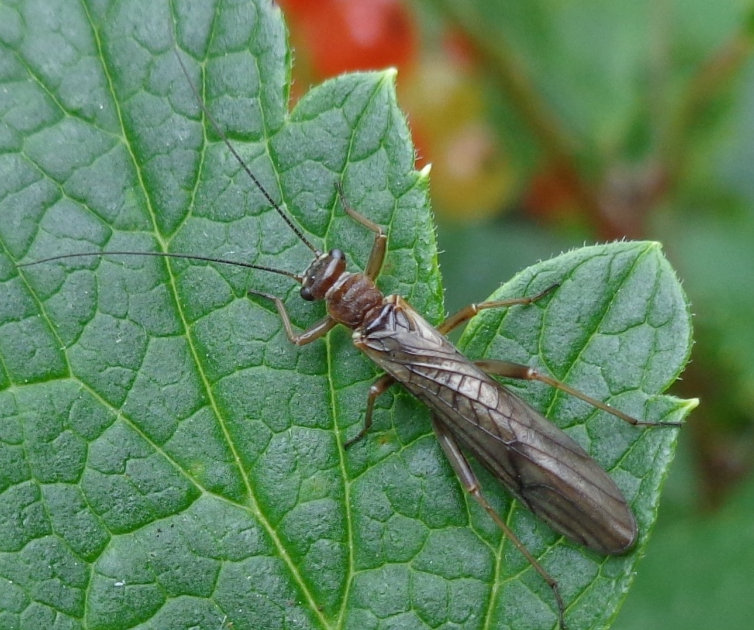Stoneflies
Stoneflies are insects in the order Plecoptera. This is a very early and primitive group of winged insects, with fossils going back to the Carboniferous period more than 300 million years ago. Most are blackish brown in colour, although some are pale yellow. They are up to 20mm long with long slender antennae and most have a pair of tails (cerci) at the end of the abdomen. The wings have many veins and are folded flat over the insect’s back when at rest. The stoneflies are an exopterygote group in which the adult wings develop in successive later moults, and there is no pupal resting stage. Some species are wingless as adults.
The nymphs develop in freshwater and the adults are generally found nearby. The nymphs bear some resemblance to earwigs, particularly in the older instars when wing pads are developing. Like the adult insect, the nymphs have a pair of tails on their rear end.
Species in Britain and Ireland
Thirty four species have been found in Britain and Ireland. Most of these species have nymphs that require clean, well oxygenated water and so tend to occur in streams and rivers, and are often considered indicators of good ecological status. Some species, such Nemoura cinerea, will breed in still water and might be found in high quality garden ponds, but stoneflies do not commonly breed in gardens.

Stoneflies
Stoneflies are insects in the order Plecoptera. This is a very early and primitive group of winged insects, with fossils going back to the Carboniferous period more than 300 million years ago. Most are blackish brown in colour, although some are pale yellow. They are up to 20mm long with long slender antennae and most have a pair of tails (cerci) at the end of the abdomen. The wings have many veins and are folded flat over the insect’s back when at rest. The stoneflies are an exopterygote group in which the adult wings develop in successive later moults, and there is no pupal resting stage.
The nymphs develop in freshwater and the adults are generally found nearby. The nymphs bear some resemblance to earwigs, particularly in the older instars when wing pads are developing. Like the adult insect, the nymphs have a pair of tails on their rear end.
Species in Britain and Ireland
Thirty four species have been found in Britain and Ireland. Most of these species have nymphs that require clean, well oxygenated water and so tend to occur in streams and rivers, and are often considered indicators of good ecological status. Some species, such Nemoura cinerea, will breed in still water and might be found in high quality garden ponds, but stoneflies do not commonly breed in gardens.
Stoneflies
Stoneflies are insects in the order Plecoptera. This is a very early and primitive group of winged insects, with fossils going back to the Carboniferous period more than 300 million years ago. Most are blackish brown in colour, although some are pale yellow. They are up to 20mm long with long slender antennae and most have a pair of tails (cerci) at the end of the abdomen. The wings have many veins and are folded flat over the insect’s back when at rest. The stoneflies are an exopterygote group in which the adult wings develop in successive later moults, and there is no pupal resting stage. Some species are wingless as adults.
The nymphs develop in freshwater and the adults are generally found nearby. The nymphs bear some resemblance to earwigs, particularly in the older instars when wing pads are developing. Like the adult insect, the nymphs have a pair of tails or cerci on their rear end.
Species in Britain and Ireland
Thirty four species have been found in Britain and Ireland. Most of these species have nymphs that require clean, well oxygenated water and so tend to occur in streams and rivers, and are often considered indicators of good ecological status. Some species, such Nemoura cinerea, will breed in still water and might be found in high quality garden ponds, but stoneflies do not commonly breed in gardens.

Stonefly Nemoura cinerea. Left: adult Right: nymph showing the long posterior cerci, and the externally developing wings.
Biology
Although most adult stoneflies have wings, they are weak fliers and they usually crawl, rather than fly. Stonefly adults and nymphs are more active at night but they can be found during the day resting on waterside vegetation or sitting on rocks in or near water. The nymphs live in streams, rivers and lake margins, where they feed on algae, diatoms and decaying vegetation. In some species the older nymphs become predators of other small aquatic animals. Fly-fishers tie imitation stonefly nymphs to hook trout when the nymphs are active.
Life cycle
Female stoneflies gather their eggs into a ball and hold them on the underside of their abdomens until they are ready to release the eggs into the water. The life cycle is usually completed in one year but some species developing in cold upland streams may take two or more years to complete the nymphal stages. When the nymphs have completed their development, they crawl out of the water. The adult stonefly emerges from the final nymphal instar and is able to expand its wings.
Role of stoneflies in gardens
A typical garden pond is an unsuitable habitat for most stonefly species, so this type of insect is not often seen in gardens. If you do encounter one in your garden, please let us know.
Other sources of information
Website
Website of the Riverfly Partnership
Website of the Freshwater Biological Association
Website of the Freshwater Habitats Trust
Books
David Pryce (2005) Stoneflies Salmo trutta 8: 41- 44 Available here.
Dobson,M. Pawley,S. Fletcher,M. & Powell, A. (2012) Guide to Freshwater Invertebrates Published by Freshwater Biological Association
Hynes, H. B. N. (1977) Adults and nymphs of British stoneflies (Plecoptera). Freshwater Biological Association
Pryce, D., Macadam, C. & Brooks (2007) Guide to British stonefly (Plecoptera) families: Adults and larvae. Field Studies Council
Page text drafted by Andrew Halstead, reviewed by Andrew Salisbury, compiled by Steve Head
Stonefly Nemoura cinerea. Left: adult Right: nymph showing the long posterior cerci, and the externally developing wings.
Biology
Although most adult stoneflies have wings, they are weak fliers and they usually crawl, rather than fly. Stonefly adults and nymphs are more active at night but they can be found during the day resting on waterside vegetation or sitting on rocks in or near water. The nymphs live in streams, rivers and lake margins, where they feed on algae, diatoms and decaying vegetation. In some species the older nymphs become predators of other small aquatic animals. Fly-fishers tie imitation stonefly nymphs to hook trout when the nymphs are active.
Life cycle
Female stoneflies gather their eggs into a ball and hold them on the underside of their abdomens until they are ready to release the eggs into the water. The life cycle is usually completed in one year but some species developing in cold upland streams may take two or more years to complete the nymphal stages. When the nymphs have completed their development, they crawl out of the water. The adult stonefly emerges from the final nymphal instar and is able to expand its wings.
Role of stoneflies in gardens
A typical garden pond is an unsuitable habitat for most stonefly species, so this type of insect is not often seen in gardens. If you do encounter one in your garden, please let us know.
Other sources of information
Website
Website of the Riverfly Partnership
Website of the Freshwater Biological Association
Website of the Freshwater Habitats Trust
Books
Dobson,M. Pawley,S. Fletcher,M. & Powell, A. (2012) Guide to Freshwater Invertebrates Published by Freshwater Biological Association
Hynes, H. B. N. (1977) Adults and nymphs of British stoneflies (Plecoptera). Freshwater Biological Association
Pryce, D., Macadam, C. & Brooks (2007) Guide to British stonefly (Plecoptera) families: Adults and larvae. Field Studies Council
Page text drafted by Andrew Halstead, reviewed by Andrew Salisbury, compiled by Steve Head


- Home
- Garden Wildlife
- Insects
- Stoneflies












